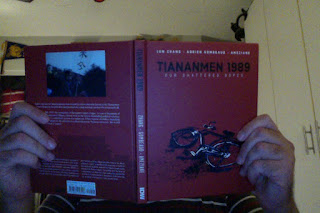Lucas Blogs About Tiananmen 1989
 |
| I don't have a joke about this one. |
So, what's this book's deal?
Tiananmen 1989: Our Shattered Hopes is a graphic novel (I will never not feel pretentious typing those words) about the events leading up to the Chinese government crackdown on the pro-democracy demonstrations that had taken place in Tiananmen Square in the Spring of 1989.
Sounds a little heavy, are you sure you want to do this one in the Hypothetical Reader format?
Well, we've already started haven't we?
It's never too late to turn back.
Nah, it'll be fine. Anyway, Tiananmen 1989 was co-written by Lun Zhang a sociology professor who helped the student protesters organize and French journalist Adrien Gombeaud with art by Améziane. Zhang's dedication makes it clear that it is not a strictly autobiographical account, and that it presents a condensed version of the events portrayed. Formally, it's structured as a lecture, with the fictionalized Zhang addressing the reader from a stage and narrating the events leading up the protests. Reforms in the wake of the death of Mao and the fallout of the Cultural Revolution led to increased personal and economic freedoms and many young people saw an opportunity to advocate for democracy. Zhang and Gombeaud's narrative switches between a bird's eye view that tries to document the important historical events that influenced the movement, and following the young Zhang as he becomes involved in the protests at Tiananmen Square. It's an effective narrative technique which allows the reader to see both the personal stakes for the young people involved and the larger societal impact of events. As far as what is autobiographical and what is fictionalized, I'm not sure, but I suspect one particular subplot is fiction.
Oh?
Well, see, one of the characters is a young woman who loves Nena's "99 Luftballons."
As do all right-thinking people. But what specifically makes you think it must be an invention of the author?
So, she explains that the lyrics of the song are about an incident in which military officials mistake ninety-nine balloons for hostile aircraft and their disproportional response triggers a war. And after six weeks of non-violent student demonstrations, the Chinese Communist Party leadership deployed the military to clear the square, resulting in a massacre seen around the world.
That does seem a little on the nose.
Yeah, the correlation is a bit obvious, and sticks out as one of the more artful elements of a narrative that is otherwise more occupied with education. With the narrative frame of the lecture and the focus on contextualizing events, it's clear that Zhang and Gombeaud want to ensure that younger people know more about the events in Tiananmen Square than the photo of Tank Man (which was taken the day after the massacre, Tank Man's fate and identity remain unknown). And on this point they definitely succeed. I'll admit, that my knowledge of the Tiananmen Square protests could probably be summed up with a single sentence and you know, the photo of Tank Man (to be fair, even though these events happened within my lifetime, I was five). So, even if aspects of the story are fictionalized, it does seem like this would make a good jumping off point.
And is the art any good?
It is, I was not familiar with Améziane so I can't say whether this is representative of his work. However, I like the way he's handled this material. Most of the book has a documentary feel, with largely realistic (if simplified) figures and faces and a washed-out color palette that evokes faded photographs. With a few exceptions his drawings and page layouts aren't flashy, they are effective. Whether it's a full page image of a young student organizer displaying their list of demands, a stark image of an IV drip in a hunger striker's arm, or tightly packed frames depicting the violence of the government response, Améziane is able to create iconic pictures that enhance the emotional impact of the work.
It does seem like a story about state violence against protesters would hit a bit harder in the US in 2020.
Well, the US does have a bit of history of meeting civil rights protests with force, but yeah. Also there's ongoing clash between pro-democracy protesters and police in Hong Kong, where China continues to erode civil liberties. In the epilogue, Zhang and Gombeaud find hope in the annual vigil held in Hong Kong's Victoria Park to honor the memory of those who died at Tiananmen. And while tens of thousands of people still attended the event this year, it's also the first year that it was officially banned.
Well, this is taking a bleak turn.
Yeah, I'm calling it. Anyway, it's a good book.
Tiananmen 1989: Our Shattered Hopes written by Lun Zhang and Adrien Gombeaud, drawn by Améziane (trans. Edward Gauvin), IDW hardcover edition, 2020 (originally published in France as Tiananmen 1989 Nos espoirs bríses in 2019), 112 pages, pairs well with idealistic late night bull sessions and sobering realities
Links:
Comments
Post a Comment